
Dissertation Structure & Layout 101: How to structure your dissertation, thesis or research project.
By: Derek Jansen (MBA) Reviewed By: David Phair (PhD) | July 2019
So, you’ve got a decent understanding of what a dissertation is , you’ve chosen your topic and hopefully you’ve received approval for your research proposal . Awesome! Now its time to start the actual dissertation or thesis writing journey.
To craft a high-quality document, the very first thing you need to understand is dissertation structure . In this post, we’ll walk you through the generic dissertation structure and layout, step by step. We’ll start with the big picture, and then zoom into each chapter to briefly discuss the core contents. If you’re just starting out on your research journey, you should start with this post, which covers the big-picture process of how to write a dissertation or thesis .

*The Caveat *
In this post, we’ll be discussing a traditional dissertation/thesis structure and layout, which is generally used for social science research across universities, whether in the US, UK, Europe or Australia. However, some universities may have small variations on this structure (extra chapters, merged chapters, slightly different ordering, etc).
So, always check with your university if they have a prescribed structure or layout that they expect you to work with. If not, it’s safe to assume the structure we’ll discuss here is suitable. And even if they do have a prescribed structure, you’ll still get value from this post as we’ll explain the core contents of each section.
Overview: S tructuring a dissertation or thesis
- Acknowledgements page
- Abstract (or executive summary)
- Table of contents , list of figures and tables
- Chapter 1: Introduction
- Chapter 2: Literature review
- Chapter 3: Methodology
- Chapter 4: Results
- Chapter 5: Discussion
- Chapter 6: Conclusion
- Reference list
As I mentioned, some universities will have slight variations on this structure. For example, they want an additional “personal reflection chapter”, or they might prefer the results and discussion chapter to be merged into one. Regardless, the overarching flow will always be the same, as this flow reflects the research process , which we discussed here – i.e.:
- The introduction chapter presents the core research question and aims .
- The literature review chapter assesses what the current research says about this question.
- The methodology, results and discussion chapters go about undertaking new research about this question.
- The conclusion chapter (attempts to) answer the core research question .
In other words, the dissertation structure and layout reflect the research process of asking a well-defined question(s), investigating, and then answering the question – see below.

To restate that – the structure and layout of a dissertation reflect the flow of the overall research process . This is essential to understand, as each chapter will make a lot more sense if you “get” this concept. If you’re not familiar with the research process, read this post before going further.
Right. Now that we’ve covered the big picture, let’s dive a little deeper into the details of each section and chapter. Oh and by the way, you can also grab our free dissertation/thesis template here to help speed things up.
The title page of your dissertation is the very first impression the marker will get of your work, so it pays to invest some time thinking about your title. But what makes for a good title? A strong title needs to be 3 things:
- Succinct (not overly lengthy or verbose)
- Specific (not vague or ambiguous)
- Representative of the research you’re undertaking (clearly linked to your research questions)
Typically, a good title includes mention of the following:
- The broader area of the research (i.e. the overarching topic)
- The specific focus of your research (i.e. your specific context)
- Indication of research design (e.g. quantitative , qualitative , or mixed methods ).
For example:
A quantitative investigation [research design] into the antecedents of organisational trust [broader area] in the UK retail forex trading market [specific context/area of focus].
Again, some universities may have specific requirements regarding the format and structure of the title, so it’s worth double-checking expectations with your institution (if there’s no mention in the brief or study material).

Acknowledgements
This page provides you with an opportunity to say thank you to those who helped you along your research journey. Generally, it’s optional (and won’t count towards your marks), but it is academic best practice to include this.
So, who do you say thanks to? Well, there’s no prescribed requirements, but it’s common to mention the following people:
- Your dissertation supervisor or committee.
- Any professors, lecturers or academics that helped you understand the topic or methodologies.
- Any tutors, mentors or advisors.
- Your family and friends, especially spouse (for adult learners studying part-time).
There’s no need for lengthy rambling. Just state who you’re thankful to and for what (e.g. thank you to my supervisor, John Doe, for his endless patience and attentiveness) – be sincere. In terms of length, you should keep this to a page or less.
Abstract or executive summary
The dissertation abstract (or executive summary for some degrees) serves to provide the first-time reader (and marker or moderator) with a big-picture view of your research project. It should give them an understanding of the key insights and findings from the research, without them needing to read the rest of the report – in other words, it should be able to stand alone .
For it to stand alone, your abstract should cover the following key points (at a minimum):
- Your research questions and aims – what key question(s) did your research aim to answer?
- Your methodology – how did you go about investigating the topic and finding answers to your research question(s)?
- Your findings – following your own research, what did do you discover?
- Your conclusions – based on your findings, what conclusions did you draw? What answers did you find to your research question(s)?
So, in much the same way the dissertation structure mimics the research process, your abstract or executive summary should reflect the research process, from the initial stage of asking the original question to the final stage of answering that question.
In practical terms, it’s a good idea to write this section up last , once all your core chapters are complete. Otherwise, you’ll end up writing and rewriting this section multiple times (just wasting time). For a step by step guide on how to write a strong executive summary, check out this post .
Need a helping hand?
Table of contents
This section is straightforward. You’ll typically present your table of contents (TOC) first, followed by the two lists – figures and tables. I recommend that you use Microsoft Word’s automatic table of contents generator to generate your TOC. If you’re not familiar with this functionality, the video below explains it simply:
If you find that your table of contents is overly lengthy, consider removing one level of depth. Oftentimes, this can be done without detracting from the usefulness of the TOC.
Right, now that the “admin” sections are out of the way, its time to move on to your core chapters. These chapters are the heart of your dissertation and are where you’ll earn the marks. The first chapter is the introduction chapter – as you would expect, this is the time to introduce your research…
It’s important to understand that even though you’ve provided an overview of your research in your abstract, your introduction needs to be written as if the reader has not read that (remember, the abstract is essentially a standalone document). So, your introduction chapter needs to start from the very beginning, and should address the following questions:
- What will you be investigating (in plain-language, big picture-level)?
- Why is that worth investigating? How is it important to academia or business? How is it sufficiently original?
- What are your research aims and research question(s)? Note that the research questions can sometimes be presented at the end of the literature review (next chapter).
- What is the scope of your study? In other words, what will and won’t you cover ?
- How will you approach your research? In other words, what methodology will you adopt?
- How will you structure your dissertation? What are the core chapters and what will you do in each of them?
These are just the bare basic requirements for your intro chapter. Some universities will want additional bells and whistles in the intro chapter, so be sure to carefully read your brief or consult your research supervisor.
If done right, your introduction chapter will set a clear direction for the rest of your dissertation. Specifically, it will make it clear to the reader (and marker) exactly what you’ll be investigating, why that’s important, and how you’ll be going about the investigation. Conversely, if your introduction chapter leaves a first-time reader wondering what exactly you’ll be researching, you’ve still got some work to do.
Now that you’ve set a clear direction with your introduction chapter, the next step is the literature review . In this section, you will analyse the existing research (typically academic journal articles and high-quality industry publications), with a view to understanding the following questions:
- What does the literature currently say about the topic you’re investigating?
- Is the literature lacking or well established? Is it divided or in disagreement?
- How does your research fit into the bigger picture?
- How does your research contribute something original?
- How does the methodology of previous studies help you develop your own?
Depending on the nature of your study, you may also present a conceptual framework towards the end of your literature review, which you will then test in your actual research.
Again, some universities will want you to focus on some of these areas more than others, some will have additional or fewer requirements, and so on. Therefore, as always, its important to review your brief and/or discuss with your supervisor, so that you know exactly what’s expected of your literature review chapter.

Now that you’ve investigated the current state of knowledge in your literature review chapter and are familiar with the existing key theories, models and frameworks, its time to design your own research. Enter the methodology chapter – the most “science-ey” of the chapters…
In this chapter, you need to address two critical questions:
- Exactly HOW will you carry out your research (i.e. what is your intended research design)?
- Exactly WHY have you chosen to do things this way (i.e. how do you justify your design)?
Remember, the dissertation part of your degree is first and foremost about developing and demonstrating research skills . Therefore, the markers want to see that you know which methods to use, can clearly articulate why you’ve chosen then, and know how to deploy them effectively.
Importantly, this chapter requires detail – don’t hold back on the specifics. State exactly what you’ll be doing, with who, when, for how long, etc. Moreover, for every design choice you make, make sure you justify it.
In practice, you will likely end up coming back to this chapter once you’ve undertaken all your data collection and analysis, and revise it based on changes you made during the analysis phase. This is perfectly fine. Its natural for you to add an additional analysis technique, scrap an old one, etc based on where your data lead you. Of course, I’m talking about small changes here – not a fundamental switch from qualitative to quantitative, which will likely send your supervisor in a spin!
You’ve now collected your data and undertaken your analysis, whether qualitative, quantitative or mixed methods. In this chapter, you’ll present the raw results of your analysis . For example, in the case of a quant study, you’ll present the demographic data, descriptive statistics, inferential statistics , etc.
Typically, Chapter 4 is simply a presentation and description of the data, not a discussion of the meaning of the data. In other words, it’s descriptive, rather than analytical – the meaning is discussed in Chapter 5. However, some universities will want you to combine chapters 4 and 5, so that you both present and interpret the meaning of the data at the same time. Check with your institution what their preference is.
Now that you’ve presented the data analysis results, its time to interpret and analyse them. In other words, its time to discuss what they mean, especially in relation to your research question(s).
What you discuss here will depend largely on your chosen methodology. For example, if you’ve gone the quantitative route, you might discuss the relationships between variables . If you’ve gone the qualitative route, you might discuss key themes and the meanings thereof. It all depends on what your research design choices were.
Most importantly, you need to discuss your results in relation to your research questions and aims, as well as the existing literature. What do the results tell you about your research questions? Are they aligned with the existing research or at odds? If so, why might this be? Dig deep into your findings and explain what the findings suggest, in plain English.
The final chapter – you’ve made it! Now that you’ve discussed your interpretation of the results, its time to bring it back to the beginning with the conclusion chapter . In other words, its time to (attempt to) answer your original research question s (from way back in chapter 1). Clearly state what your conclusions are in terms of your research questions. This might feel a bit repetitive, as you would have touched on this in the previous chapter, but its important to bring the discussion full circle and explicitly state your answer(s) to the research question(s).

Next, you’ll typically discuss the implications of your findings . In other words, you’ve answered your research questions – but what does this mean for the real world (or even for academia)? What should now be done differently, given the new insight you’ve generated?
Lastly, you should discuss the limitations of your research, as well as what this means for future research in the area. No study is perfect, especially not a Masters-level. Discuss the shortcomings of your research. Perhaps your methodology was limited, perhaps your sample size was small or not representative, etc, etc. Don’t be afraid to critique your work – the markers want to see that you can identify the limitations of your work. This is a strength, not a weakness. Be brutal!
This marks the end of your core chapters – woohoo! From here on out, it’s pretty smooth sailing.
The reference list is straightforward. It should contain a list of all resources cited in your dissertation, in the required format, e.g. APA , Harvard, etc.
It’s essential that you use reference management software for your dissertation. Do NOT try handle your referencing manually – its far too error prone. On a reference list of multiple pages, you’re going to make mistake. To this end, I suggest considering either Mendeley or Zotero. Both are free and provide a very straightforward interface to ensure that your referencing is 100% on point. I’ve included a simple how-to video for the Mendeley software (my personal favourite) below:
Some universities may ask you to include a bibliography, as opposed to a reference list. These two things are not the same . A bibliography is similar to a reference list, except that it also includes resources which informed your thinking but were not directly cited in your dissertation. So, double-check your brief and make sure you use the right one.
The very last piece of the puzzle is the appendix or set of appendices. This is where you’ll include any supporting data and evidence. Importantly, supporting is the keyword here.
Your appendices should provide additional “nice to know”, depth-adding information, which is not critical to the core analysis. Appendices should not be used as a way to cut down word count (see this post which covers how to reduce word count ). In other words, don’t place content that is critical to the core analysis here, just to save word count. You will not earn marks on any content in the appendices, so don’t try to play the system!
Time to recap…
And there you have it – the traditional dissertation structure and layout, from A-Z. To recap, the core structure for a dissertation or thesis is (typically) as follows:
- Acknowledgments page
Most importantly, the core chapters should reflect the research process (asking, investigating and answering your research question). Moreover, the research question(s) should form the golden thread throughout your dissertation structure. Everything should revolve around the research questions, and as you’ve seen, they should form both the start point (i.e. introduction chapter) and the endpoint (i.e. conclusion chapter).
I hope this post has provided you with clarity about the traditional dissertation/thesis structure and layout. If you have any questions or comments, please leave a comment below, or feel free to get in touch with us. Also, be sure to check out the rest of the Grad Coach Blog .

Psst... there’s more!
This post was based on one of our popular Research Bootcamps . If you're working on a research project, you'll definitely want to check this out ...
You Might Also Like:

36 Comments
many thanks i found it very useful
Glad to hear that, Arun. Good luck writing your dissertation.
Such clear practical logical advice. I very much needed to read this to keep me focused in stead of fretting.. Perfect now ready to start my research!
what about scientific fields like computer or engineering thesis what is the difference in the structure? thank you very much
Thanks so much this helped me a lot!
Very helpful and accessible. What I like most is how practical the advice is along with helpful tools/ links.
Thanks Ade!
Thank you so much sir.. It was really helpful..
You’re welcome!
Hi! How many words maximum should contain the abstract?
Thank you so much 😊 Find this at the right moment
You’re most welcome. Good luck with your dissertation.
best ever benefit i got on right time thank you
Many times Clarity and vision of destination of dissertation is what makes the difference between good ,average and great researchers the same way a great automobile driver is fast with clarity of address and Clear weather conditions .
I guess Great researcher = great ideas + knowledge + great and fast data collection and modeling + great writing + high clarity on all these
You have given immense clarity from start to end.
Morning. Where will I write the definitions of what I’m referring to in my report?
Thank you so much Derek, I was almost lost! Thanks a tonnnn! Have a great day!
Thanks ! so concise and valuable
This was very helpful. Clear and concise. I know exactly what to do now.
Thank you for allowing me to go through briefly. I hope to find time to continue.
Really useful to me. Thanks a thousand times
Very interesting! It will definitely set me and many more for success. highly recommended.
Thank you soo much sir, for the opportunity to express my skills
Usefull, thanks a lot. Really clear
Very nice and easy to understand. Thank you .
That was incredibly useful. Thanks Grad Coach Crew!
My stress level just dropped at least 15 points after watching this. Just starting my thesis for my grad program and I feel a lot more capable now! Thanks for such a clear and helpful video, Emma and the GradCoach team!
Do we need to mention the number of words the dissertation contains in the main document?
It depends on your university’s requirements, so it would be best to check with them 🙂
Such a helpful post to help me get started with structuring my masters dissertation, thank you!
Great video; I appreciate that helpful information
It is so necessary or avital course
This blog is very informative for my research. Thank you
Doctoral students are required to fill out the National Research Council’s Survey of Earned Doctorates
wow this is an amazing gain in my life
This is so good
How can i arrange my specific objectives in my dissertation?
Trackbacks/Pingbacks
- What Is A Literature Review (In A Dissertation Or Thesis) - Grad Coach - […] is to write the actual literature review chapter (this is usually the second chapter in a typical dissertation or…
Submit a Comment Cancel reply
Your email address will not be published. Required fields are marked *
Save my name, email, and website in this browser for the next time I comment.
- Print Friendly
- Privacy Policy

Home » Thesis Format – Templates and Samples
Thesis Format – Templates and Samples
Table of contents.

Thesis Format
Thesis format refers to the structure and layout of a research thesis or dissertation. It typically includes several chapters, each of which focuses on a particular aspect of the research topic .
The exact format of a thesis can vary depending on the academic discipline and the institution, but some common elements include:
Introduction
Literature review, methodology.
The title page is the first page of a thesis that provides essential information about the document, such as the title, author’s name, degree program, university, and the date of submission. It is considered as an important component of a thesis as it gives the reader an initial impression of the document’s content and quality.
The typical contents of a title page in a thesis include:
- The title of the thesis: It should be concise, informative, and accurately represent the main topic of the research.
- Author’s name: This should be written in full and should be the same as it appears on official university records.
- Degree program and department: This should specify the type of degree (e.g., Bachelor’s, Master’s, or Doctoral) and the field of study (e.g., Computer Science, Psychology, etc.).
- University: The name of the university where the thesis is being submitted.
- Date of submission : The month and year of submission of the thesis.
- Other details that can be included on the title page include the name of the advisor, the name of the committee members, and any acknowledgments.
In terms of formatting, the title page should be centered horizontally and vertically on the page, with a consistent font size and style. The page margin for the title page should be at least 1 inch (2.54 cm) on all sides. Additionally, it is common practice to include the university logo or crest on the title page, and this should be placed appropriately.
Title of the Thesis in Title Case by Author’s Full Name in Title Case
A thesis submitted in partial fulfillment of the requirements for the degree of Master of Science in Department Name at the University Name
Month Year of Submission
An abstract is a brief summary of a thesis or research paper that provides an overview of the main points, methodology, and findings of the study. It is typically placed at the beginning of the document, after the title page and before the introduction.
The purpose of an abstract is to provide readers with a quick and concise overview of the research paper or thesis. It should be written in a clear and concise language, and should not contain any jargon or technical terms that are not easily understood by the general public.
Here’s an example of an abstract for a thesis:
Title: The Impact of Social Media on Mental Health among Adolescents
This study examines the impact of social media on mental health among adolescents. The research utilized a survey methodology and collected data from a sample of 500 adolescents aged between 13 and 18 years. The findings reveal that social media has a significant impact on mental health among adolescents, with frequent use of social media associated with higher levels of anxiety, depression, and low self-esteem. The study concludes that there is a need for increased awareness and education on the risks associated with excessive use of social media, and recommends strategies for promoting healthy social media habits among adolescents.
In this example, the abstract provides a concise summary of the thesis by highlighting the main points, methodology, and findings of the study. It also provides a clear indication of the significance of the study and its implications for future research and practice.
A table of contents is an essential part of a thesis as it provides the reader with an overview of the entire document’s structure and organization.
Here’s an example of how a table of contents might look in a thesis:
TABLE OF CONTENTS
I. INTRODUCTION ……………………………………………………..1
A. Background of the Study………………………………………..1
B. Statement of the Problem……………………………………….2
C. Objectives of the Study………………………………………..3
D. Research Questions…………………………………………….4
E. Significance of the Study………………………………………5
F. Scope and Limitations………………………………………….6
G. Definition of Terms……………………………………………7
II. LITERATURE REVIEW. ………………………………………………8
A. Overview of the Literature……………………………………..8
B. Key Themes and Concepts………………………………………..9
C. Gaps in the Literature………………………………………..10
D. Theoretical Framework………………………………………….11
III. METHODOLOGY ……………………………………………………12
A. Research Design………………………………………………12
B. Participants and Sampling……………………………………..13
C. Data Collection Procedures…………………………………….14
D. Data Analysis Procedures………………………………………15
IV. RESULTS …………………………………………………………16
A. Descriptive Statistics…………………………………………16
B. Inferential Statistics…………………………………………17
V. DISCUSSION ………………………………………………………18
A. Interpretation of Results………………………………………18
B. Discussion of Finding s …………………………………………19
C. Implications of the Study………………………………………20
VI. CONCLUSION ………………………………………………………21
A. Summary of the Study…………………………………………..21
B. Limitations of the Study……………………………………….22
C. Recommendations for Future Research……………………………..23
REFERENCES …………………………………………………………….24
APPENDICES …………………………………………………………….26
As you can see, the table of contents is organized by chapters and sections. Each chapter and section is listed with its corresponding page number, making it easy for the reader to navigate the thesis.
The introduction is a critical part of a thesis as it provides an overview of the research problem, sets the context for the study, and outlines the research objectives and questions. The introduction is typically the first chapter of a thesis and serves as a roadmap for the reader.
Here’s an example of how an introduction in a thesis might look:
Introduction:
The prevalence of obesity has increased rapidly in recent decades, with more than one-third of adults in the United States being classified as obese. Obesity is associated with numerous adverse health outcomes, including cardiovascular disease, diabetes, and certain cancers. Despite significant efforts to address this issue, the rates of obesity continue to rise. The purpose of this study is to investigate the relationship between lifestyle behaviors and obesity in young adults.
The study will be conducted using a mixed-methods approach, with both qualitative and quantitative data collection methods. The research objectives are to:
- Examine the relationship between lifestyle behaviors and obesity in young adults.
- Identify the key lifestyle factors that contribute to obesity in young adults.
- Evaluate the effectiveness of current interventions aimed at preventing and reducing obesity in young adults.
The research questions that will guide this study are:
- What is the relationship between lifestyle behaviors and obesity in young adults?
- Which lifestyle factors are most strongly associated with obesity in young adults?
- How effective are current interventions aimed at preventing and reducing obesity in young adults?
By addressing these research questions, this study aims to contribute to the understanding of the factors that contribute to obesity in young adults and to inform the development of effective interventions to prevent and reduce obesity in this population.
A literature review is a critical analysis and evaluation of existing literature on a specific topic or research question. It is an essential part of any thesis, as it provides a comprehensive overview of the existing research on the topic and helps to establish the theoretical framework for the study. The literature review allows the researcher to identify gaps in the current research, highlight areas that need further exploration, and demonstrate the importance of their research question.
April 9, 2023:
A search on Google Scholar for “Effectiveness of Online Learning during the COVID-19 Pandemic” yielded 1,540 results. Upon reviewing the first few pages of results, it is evident that there is a significant amount of literature on the topic. A majority of the studies focus on the experiences and perspectives of students and educators during the transition to online learning due to the pandemic.
One recent study published in the Journal of Educational Technology & Society (Liu et al., 2023) found that students who were already familiar with online learning tools and platforms had an easier time adapting to online learning than those who were not. However, the study also found that students who were not familiar with online learning tools were able to adapt with proper support from their teachers and institutions.
Another study published in Computers & Education (Tang et al., 2023) compared the academic performance of students in online and traditional classroom settings during the pandemic. The study found that while there were no significant differences in the grades of students in the two settings, students in online classes reported higher levels of stress and lower levels of satisfaction with their learning experience.
Methodology in a thesis refers to the overall approach and systematic process that a researcher follows to collect and analyze data in order to answer their research question(s) or achieve their research objectives. It includes the research design, data collection methods, sampling techniques, data analysis procedures, and any other relevant procedures that the researcher uses to conduct their research.
For example, let’s consider a thesis on the impact of social media on mental health among teenagers. The methodology for this thesis might involve the following steps:
Research Design:
The researcher may choose to conduct a quantitative study using a survey questionnaire to collect data on social media usage and mental health among teenagers. Alternatively, they may conduct a qualitative study using focus group discussions or interviews to gain a deeper understanding of the experiences and perspectives of teenagers regarding social media and mental health.
Sampling Techniques:
The researcher may use random sampling to select a representative sample of teenagers from a specific geographic location or demographic group, or they may use purposive sampling to select participants who meet specific criteria such as age, gender, or mental health status.
Data Collection Methods:
The researcher may use an online survey tool to collect data on social media usage and mental health, or they may conduct face-to-face interviews or focus group discussions to gather qualitative data. They may also use existing data sources such as medical records or social media posts.
Data Analysis Procedures:
The researcher may use statistical analysis techniques such as regression analysis to examine the relationship between social media usage and mental health, or they may use thematic analysis to identify key themes and patterns in the qualitative data.
Ethical Considerations: The researcher must ensure that their research is conducted in an ethical manner, which may involve obtaining informed consent from participants, protecting their confidentiality, and ensuring that their rights and welfare are respected.
In a thesis, the “Results” section typically presents the findings of the research conducted by the author. This section typically includes both quantitative and qualitative data, such as statistical analyses, tables, figures, and other relevant data.
Here are some examples of how the “Results” section of a thesis might look:
Example 1: A quantitative study on the effects of exercise on cardiovascular health
In this study, the author conducts a randomized controlled trial to investigate the effects of exercise on cardiovascular health in a group of sedentary adults. The “Results” section might include tables showing the changes in blood pressure, cholesterol levels, and other relevant indicators in the exercise and control groups over the course of the study. The section might also include statistical analyses, such as t-tests or ANOVA, to demonstrate the significance of the results.
Example 2: A qualitative study on the experiences of immigrant families in a new country
In this study, the author conducts in-depth interviews with immigrant families to explore their experiences of adapting to a new country. The “Results” section might include quotes from the interviews that illustrate the participants’ experiences, as well as a thematic analysis that identifies common themes and patterns in the data. The section might also include a discussion of the implications of the findings for policy and practice.
A thesis discussion section is an opportunity for the author to present their interpretation and analysis of the research results. In this section, the author can provide their opinion on the findings, compare them with other literature, and suggest future research directions.
For example, let’s say the thesis topic is about the impact of social media on mental health. The author has conducted a survey among 500 individuals and has found that there is a significant correlation between excessive social media use and poor mental health.
In the discussion section, the author can start by summarizing the main findings and stating their interpretation of the results. For instance, the author may argue that excessive social media use is likely to cause mental health problems due to the pressure of constantly comparing oneself to others, fear of missing out, and cyberbullying.
Next, the author can compare their results with other studies and point out similarities and differences. They can also identify any limitations in their research design and suggest future directions for research.
For example, the author may point out that their study only measured social media use and mental health at one point in time, and it is unclear whether one caused the other or whether there are other confounding factors. Therefore, they may suggest longitudinal studies that follow individuals over time to better understand the causal relationship.
Writing a conclusion for a thesis is an essential part of the overall writing process. The conclusion should summarize the main points of the thesis and provide a sense of closure to the reader. It is also an opportunity to reflect on the research process and offer suggestions for further study.
Here is an example of a conclusion for a thesis:
After an extensive analysis of the data collected, it is evident that the implementation of a new curriculum has had a significant impact on student achievement. The findings suggest that the new curriculum has improved student performance in all subject areas, and this improvement is particularly notable in math and science. The results of this study provide empirical evidence to support the notion that curriculum reform can positively impact student learning outcomes.
In addition to the positive results, this study has also identified areas for future research. One limitation of the current study is that it only examines the short-term effects of the new curriculum. Future studies should explore the long-term effects of the new curriculum on student performance, as well as investigate the impact of the curriculum on students with different learning styles and abilities.
Overall, the findings of this study have important implications for educators and policymakers who are interested in improving student outcomes. The results of this study suggest that the implementation of a new curriculum can have a positive impact on student achievement, and it is recommended that schools and districts consider curriculum reform as a means of improving student learning outcomes.
References in a thesis typically follow a specific format depending on the citation style required by your academic institution or publisher.
Below are some examples of different citation styles and how to reference different types of sources in your thesis:
In-text citation format: (Author, Year)
Reference list format for a book: Author, A. A. (Year of publication). Title of work: Capital letter also for subtitle. Publisher.
Example: In-text citation: (Smith, 2010) Reference list entry: Smith, J. D. (2010). The art of writing a thesis. Cambridge University Press.
Reference list format for a journal article: Author, A. A., Author, B. B., & Author, C. C. (Year of publication). Title of article. Title of Journal, volume number(issue number), page range.
Example: In-text citation: (Brown, 2015) Reference list entry: Brown, E., Smith, J., & Johnson, L. (2015). The impact of social media on academic performance. Journal of Educational Psychology, 108(3), 393-407.
In-text citation format: (Author page number)
Works Cited list format for a book: Author. Title of Book. Publisher, Year of publication.
Example: In-text citation: (Smith 75) Works Cited entry: Smith, John D. The Art of Writing a Thesis. Cambridge University Press, 2010.
Works Cited list format for a journal article: Author(s). “Title of Article.” Title of Journal, volume number, issue number, date, pages.
Example: In-text citation: (Brown 394) Works Cited entry: Brown, Elizabeth, et al. “The Impact of Social Media on Academic Performance.” Journal of Educational Psychology, vol. 108, no. 3, 2015, pp. 393-407.
Chicago Style
In-text citation format: (Author year, page number)
Bibliography list format for a book: Author. Title of Book. Place of publication: Publisher, Year of publication.
Example: In-text citation: (Smith 2010, 75) Bibliography entry: Smith, John D. The Art of Writing a Thesis. Cambridge: Cambridge University Press, 2010.
Bibliography list format for a journal article: Author. “Title of Article.” Title of Journal volume number, no. issue number (date): page numbers.
Example: In-text citation: (Brown 2015, 394) Bibliography entry: Brown, Elizabeth, John Smith, and Laura Johnson. “The Impact of Social Media on Academic Performance.” Journal of Educational Psychology 108, no. 3 (2015): 393-407.
Reference list format for a book: [1] A. A. Author, Title of Book. City of Publisher, Abbrev. of State: Publisher, year.
Example: In-text citation: [1] Reference list entry: A. J. Smith, The Art of Writing a Thesis. New York, NY: Academic Press, 2010.
Reference list format for a journal article: [1] A. A. Author, “Title of Article,” Title of Journal, vol. x, no. x, pp. xxx-xxx, Month year.
Example: In-text citation: [1] Reference list entry: E. Brown, J. D. Smith, and L. Johnson, “The Impact of Social Media on Academic Performance,” Journal of Educational Psychology, vol. 108, no. 3, pp. 393-407, Mar. 2015.
An appendix in a thesis is a section that contains additional information that is not included in the main body of the document but is still relevant to the topic being discussed. It can include figures, tables, graphs, data sets, sample questionnaires, or any other supplementary material that supports your thesis.
Here is an example of how you can format appendices in your thesis:
- Title page: The appendix should have a separate title page that lists the title, author’s name, the date, and the document type (i.e., thesis or dissertation). The title page should be numbered as the first page of the appendix section.
- Table of contents: If you have more than one appendix, you should include a separate table of contents that lists each appendix and its page number. The table of contents should come after the title page.
- Appendix sections: Each appendix should have its own section with a clear and concise title that describes the contents of the appendix. Each section should be numbered with Arabic numerals (e.g., Appendix 1, Appendix 2, etc.). The sections should be listed in the table of contents.
- Formatting: The formatting of the appendices should be consistent with the rest of the thesis. This includes font size, font style, line spacing, and margins.
- Example: Here is an example of what an appendix might look like in a thesis on the topic of climate change:
Appendix 1: Data Sources
This appendix includes a list of the primary data sources used in this thesis, including their URLs and a brief description of the data they provide.
Appendix 2: Survey Questionnaire
This appendix includes the survey questionnaire used to collect data from participants in the study.
Appendix 3: Additional Figures
This appendix includes additional figures that were not included in the main body of the thesis due to space limitations. These figures provide additional support for the findings presented in the thesis.
About the author
Muhammad Hassan
Researcher, Academic Writer, Web developer
You may also like

Delimitations in Research – Types, Examples and...

Research Design – Types, Methods and Examples

Dissertation Methodology – Structure, Example...

What is a Hypothesis – Types, Examples and...

Dissertation – Format, Example and Template

Dissertation vs Thesis – Key Differences

- Library Catalogue
Formatting your thesis: Overall layout and specifications

On this page
Formatting requirements, parts of a thesis, file format, file size, and page size, line spacing, citation style, cumulative theses, extended essays, personal information, blank pages.
The Library's Theses Office assists with formatting theses, projects and extended essays for submission to the Library. You are encouraged to use the Library's thesis template to help format your thesis. The requirements stated on this page are default settings for the thesis template
Optional pages in the thesis template may be removed if not used.
The final copy of the thesis must be converted to .pdf (PDF/A format) for submission to the Library (maximum 600 mb). See the guide Saving your thesis in PDF/A format for instructions.
Theses must be formatted for US Letter (8.5X11) pages. Landscape 8.5X11 and 11X17 pages are permitted. Legal, A4, or other paper sizes are not permitted.
Arial is the preferred font for SFU thesis submissions. See the Thesis Template Instructions for directions to change the default template font.
Please contact the Theses Office at [email protected] if you would like to use any fonts in your thesis other than the ones recommended.
The default template line spacing is 1.5 for text, with single-spaced block quotations.
Margins should be set to:
- 1.25" left/right
- 1" top/bottom
All pages must be numbered sequentially as outlined below, with the exception of the title page. Page numbers should appear at the bottom centre of each page, at a minimum of 0.5” from the edge of the page.
Preliminary pages of the thesis must be numbered with Roman numerals. On the first page of the main body, page numbers must restart with 1. The thesis template is preset with this numbering style.
SFU Library does not require a specific citation style. Consult your supervisor, your department’s graduate handbook, or a liaison librarian for help with determining which style is appropriate for your research.
The default formatting in the library’s thesis template may differ from some requirements of your citation style, but it is acceptable for SFU library submission.
Cumulative, or paper-based, theses must use the same general format as other submissions. Consult your supervisor or your department's graduate handbook for more information. If including published papers in a thesis, please consult the Copyright and your thesis FAQ .
Extended essays should be combined into a single document and single submission. For an example of an extended essays title page, see the Title page formatting information .
For theses written in a language other than English, the Library requires a second complete English title page and abstract. Supporting documentation must be in English.
Individual personal information must be removed from the thesis before publication, including signatures, email addresses, and phone numbers. For example, if you are including a survey instrument or consent form, your own contact information must be removed.
Blank pages in the thesis must be removed before publication.

Undergraduate Thesis
- Preparing for Thesis
- Elements of Thesis
- List of References
- Images and Figures
- Library Home
Books on Layout
CLICK TO VIEW IN THE LIBRARY CATALOG

Sign in to Lynda.com to access this resource. If you don't have an account you can sign up here.
Designing a Book with Nigel French
Creating a book in InDesign from Designing a Book by Nigel French
Foundations of Layout and Composition: Grids with Sean Adams
Welcome from Graphic Design Foundations: Layout and Composition by Sean Adams
Graphic Design Tutorial: Designing to a Grid
NewSchool recommends Adobe InDesign for designing your thesis book. Many free templates and tutorials are available online. Try starting with Blurb.com.
The grid is your underlying structure which helps create visual hierarchy by sizing and positioning images and text to create a coherent design. The grid is the graphic expression of a set of assumptions about the permissible sizes and shapes of images and blocks of text. It enables you to achieve and sustain design consistency.
Your prime consideration for text should always be legibility. Text needs to be readable and perfectly clear. Don't allow it to compete with or obscure images; it should always work with them to explain and enhance them. Keep text clearly separate from images by spacing and/or maintaining a strong contrast between values of the images and values of the text blocks.
Familiarize yourself with type, it's legibility and emotional impact, by studying the typefaces used in books and magazines and on the web. Remember less is more--don't use more the three different fonts in any portfolio. Additionally, make sure all of the fonts are very different looking to create contrast.
Basics in Graphic Design
Remember, your thesis layout should follow graphic design standards. Here are recommended resources on design concepts including text, images, color, and white space.
See Examples of Attractive Layout Here
Ambrose / Harris. (2005). Basics Design 02: Layout. AVA Academia.
Linton, H. (2012). Portfolio Design 4th ed. W.W. Norton & Company.
- << Previous: Elements of Thesis
- Next: Examples >>
- Last Updated: Apr 23, 2024 7:16 PM
- URL: https://library.newschoolarch.edu/ugthesis

- Useful tips
- 5 tips for the perfect student thesis design
Need tips for a perfect student thesis design?
Writing your thesis is already difficult enough. That is why you can read below how to design a perfect thesis layout with 5 easy tips . This way you will without a doubt impress with your thesis layout! Whether you write your thesis in Microsoft Word, Pages (Mac) or Google Docs, you can use these tips in all these programs.
Add page numbers to your thesis?
It may seem unnecessary to mention, but many students often forget to insert page numbers. Did you know that you can change the font of your page numbers ? This way your page numbering always matches the rest of your thesis. In principle, adding page numbering is the same in almost every program. Read here how to add page numbers in Pages and here how to do this in Word.

How to make a clear table of contents?
No thesis is ready without a table of contents. The most important thing is that it is well-arranged and that the page numbers are right next to the chapters and paragraphs. Are you often struggling with the alignment of the page numbers on the rightside of the page? Then try inserting the index as a table with the left column for the chapters and the right column for the page numbers. The page numbers will be well aligned. If you do not like the lines of the table, you can easily remove them by coloring the lines white. See, a perfectly formatted table of contents!
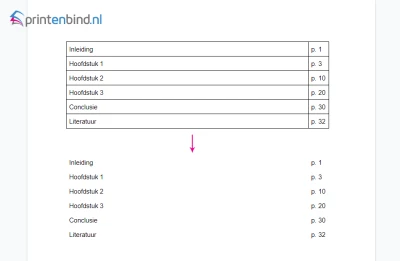
How to set the margin of your thesis?
Do you want your thesis to look good? Make sure you set the margin of the document of your thesis correctly. The margin means the distance of the text and images to the edge of your thesis. The margin is usually set well for printing your thesis by default, but check to be sure that the margin is at least 5 mm . You can read here how to check and set the margin of a Word document.
What is the right resolution of the images and tables for your thesis?
Did you do a data analysis for your thesis or did you have to transcribe interviews? The results are often shown in tables or graphs. Make sure you add these in good quality to the document of your thesis. It is better to not to save figures as an image (jpeg or png), but add figures directly via Word, Pages or Google Docs. The quality of the text of your figures will then be the same as the rest of the text in your thesis.
Through this step-by-step plan , we easily explain how you save your thesis as a PDF.
How do you secure your thesis layout?
Enter, enter, enter, until you reach the next page? Use the Page break option (ctrl + Enter, or for Mac users cmd + Enter). If you add more text, your layout will be preserved! Also useful if you want to add a white page so that the chapters all start on the same page.
Now your thesis has been prepared and is completely ready for printing and binding! Print your thesis easily and cheaply at Printenbind.nl! Within one ( urgent ) or two working days ( standard ) at home!
Also check out
- What paper type should I choose?
Our qualities
Every action is optimized for maximum efficiency
Always good quality
High quality prints that we produce ourselves
Fast delivery
Standard production within 24h
Easy ordering experience
Many options that you can easily choose yourself
- In-house production
- Influencer collaboration
- Paper types
- Sticker types
- Helpful tips
- Submitting conditions
- Shipping and delivery
- Delivery times
- Order status
- Recurring customers
- Volume discount
- Customer reviews
- Terms and conditions
- Privacy policy
Zo simpel kan het zijn
Want to stay informed.
Subscribe to our newsletter.


- Langson Library
- Science Library
- Grunigen Medical Library
- Law Library
- Connect From Off-Campus
- Accessibility
- Gateway Study Center

Email this link
Thesis / dissertation formatting manual (2024).
- Filing Fees and Student Status
- Submission Process Overview
- Electronic Thesis Submission
- Paper Thesis Submission
- Formatting Overview
- Fonts/Typeface
- Pagination, Margins, Spacing
- Paper Thesis Formatting
- Preliminary Pages Overview
- Copyright Page
- Dedication Page
- Table of Contents
- List of Figures (etc.)
- Acknowledgements
- Text and References Overview
- Figures and Illustrations
- Using Your Own Previously Published Materials
- Using Copyrighted Materials by Another Author
- Open Access and Embargoes
- Copyright and Creative Commons
- Ordering Print (Bound) Copies
- Tutorials and Assistance
- FAQ This link opens in a new window
UCI Libraries maintains the following templates to assist in formatting your graduate manuscript. If you are formatting your manuscript in Microsoft Word, feel free to download and use the template. If you would like to see what your manuscript should look like, PDFs have been provided. If you are formatting your manuscript using LaTex, UCI maintains a template on OverLeaf.
- Annotated Template (Dissertation) 2024 PDF of a template with annotations of what to look out for
- Word: Thesis Template 2024 Editable template of the Master's thesis formatting.
- PDF Thesis Template 2024
- Word: Dissertation Template 2024 Editable template of the PhD Dissertation formatting.
- PDF: Dissertation Template 2024
- Overleaf (LaTex) Template
- << Previous: Tutorials and Assistance
- Next: FAQ >>
- Last Updated: Feb 20, 2024 2:09 PM
- URL: https://guides.lib.uci.edu/gradmanual
Off-campus? Please use the Software VPN and choose the group UCIFull to access licensed content. For more information, please Click here
Software VPN is not available for guests, so they may not have access to some content when connecting from off-campus.
Gallery — Thesis
Gallery Items tagged Thesis
Show all Gallery Items
Your thesis or dissertation is often the most important single piece of work you’ll produce as a student (whether it be your final year undergraduate research project or your complete Masters / PhD thesis). These templates, many provided by the university themselves as official layout guidelines, include sections for you to add all the relevant author information (your university, department, supervisor, year, etc) along with placeholder chapters for your introduction, background, method, results, conclusion / discussion, references and appendices.

Related Tags
Have you checked our knowledge base ?
Message sent! Our team will review it and reply by email.
Library Subject Guides
4. writing up your research: thesis formatting (ms word).
- Books on Thesis Writing
- Thesis Formatting (MS Word)
- Referencing
Haere mai, tauti mai—welcome! These instructions are designed to be used with recent versions of MS Word. Please note there is no template or specific formatting guidelines for a thesis at UC. Please talk to your supervisor and take a look at theses in the UC Research Repository to see how they are usually formatted.
- Where to start
- Show/Hide Formatting
- Heading Styles
- Navigation Pane
- Table of Contents
- Numbered Headings
- List of Figures/Tables
- Page/Section Breaks, Page Numbering & Orientation
Word Thesis Formatting workshops run throughout the year.
Some useful documents.
- Word Formatting Instructions PDF This PDF contains the same instructions that are available on this page.
- Sample Thesis Document with No Formatting This sample thesis file can be used to practise formatting. It is not a template for how to format a thesis. UC does not provide any guidelines on formatting a thesis.
- APA 7th Edition Formatting Example This document is formatted according to APA 7th Edition formatting guidelines. It could be used as a template or as an example to follow. It contains some additional instructions for certain APA formatting in Word.
For more APA formatting advice see the APA Style Blog's excellent Style and Grammar Guidelines .
Finding Examples
Look at examples and ask your supervisor.
The best guide on how to format your thesis is a combination of:
- Looking at previous theses in your discipline. Search the UC Research Repository for your subject or department, and browse by issue date to get the most recent.
- Asking your supervisor for recommendations on specific formatting and details.
General Recommendations
The following is an example only of preliminaries to the thesis that could be included.
- Acknowledgements
- List of Figures
- List of Tables
- Abbreviations
- Toggle show Home ->Show/Hide formatting

Using styles for headings allows you to create an automatic table of contents.
- Select major headings one at a time and choose Home ->Styles ‘Heading 1’

- Select subheadings and apply Home ->Styles ‘heading 2’ and ‘heading 3’
- Modify a style by right clicking on it and choosing Modify in the styles pane at the top of the screen.

The Navigation Pain is useful for seeing the outline of your document as well as providing links to quickly go to any section of the document.
- View->check Navigation Pane

In order to create an automatic table of contents heading styles must be used.
- References -> Table of Contents -> Custom Table of Contents (no heading in table)
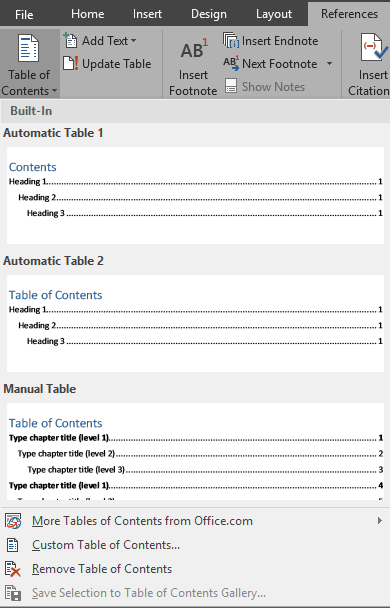
- Right click table of contents to ‘update field’ and choose ‘update entire table’
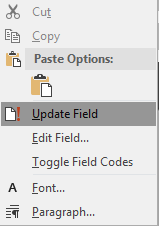
- Home->Multilevel list-> choose style with a number level for each heading level
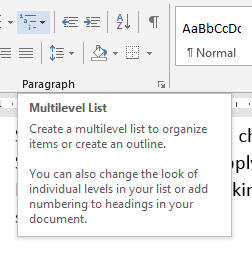
- To change the heading level 1 number to say ‘Chapter 1’ right click on heading level 1 in the styles area Heading 1->Modify .
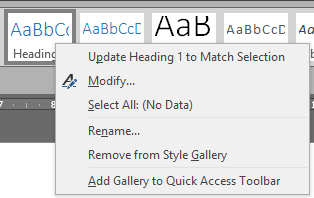
- In the modify screen click Format->Numbering.
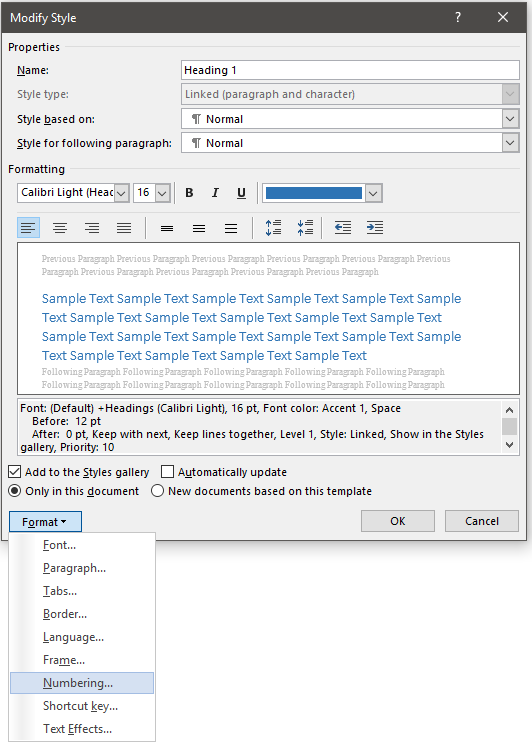
- Then click ‘ Define New Number Format’.
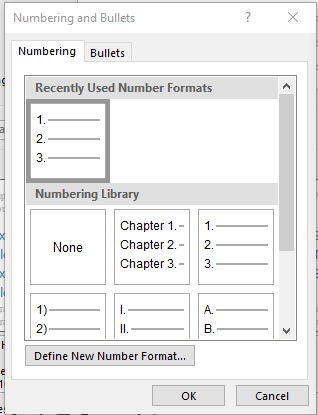
- Then add the word ‘Chapter’ and a space before the ‘1’.
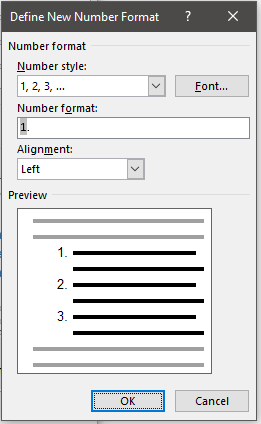
To create automatic lists of figures or tables you first have to give a caption to all your figures and tables.
- Right click figure or table and select Insert Caption
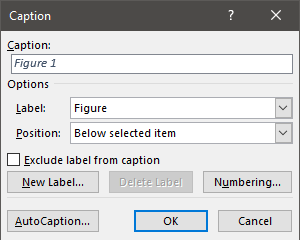
- Choose Label type eg. Figure, Table etc
- Choose position above or below
- Give the table or figure a title in the top box
- Go to the headings for List of Figures and List of tables and then click References->Insert Table of Figures -> select caption label type (Figure or Table)

- On the following menu select caption label type (Figure or Table) and click OK

This can be used to have different page numbering styles of different sections of your document or to have certain pages landscape to display a large table or graph.
- Insert a section break (next page) at the end of the title page ( Layout -> Breaks -> Next Page )
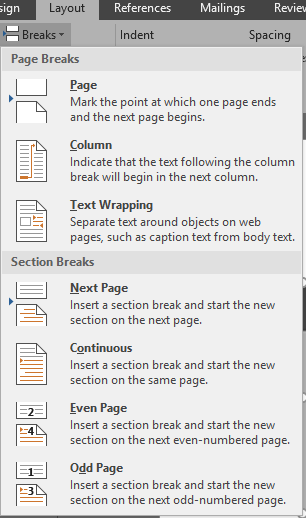
- Insert a section break at chapter 1 ( Layout -> Breaks -> Next Page )
- Insert page breaks for all other ‘heading 1’ headings ( Layout -> Breaks -> Page )
Adding Page Numbers
- Insert -> Page Number and choose a position on the page
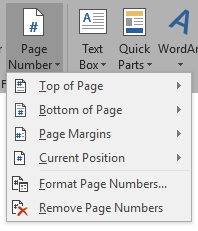
- Double click on title page header or footer (top or bottom of the page) and tick ‘ Different First Page’ in the Design ribbon that appears

- Click in second page header or footer, right click on the page number and select ‘ format page numbers ’
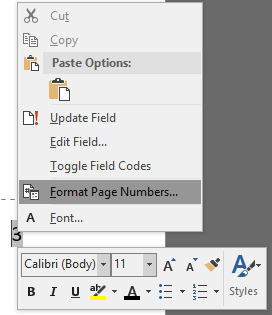
- Select Roman numerals eg. ‘i, ii, iii, iv’ etc
- Select start at ‘i’ (start at ‘1’)
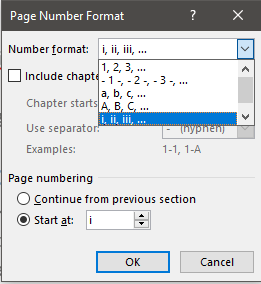
- Scroll to chapter 1 and change number style for this section back to ordinary numbers and start at 1
Change Page Orientation
- Insert a section break before and after the pages you want to change to landscape orientation (See instructions above for inserting a section break)
- Layout -> Orientation -> Landscape
NOTE: A section break is usually only needed if page orientation or separate page numbers are required.
- << Previous: Books on Thesis Writing
- Next: Referencing >>
- Last Updated: Feb 8, 2024 12:29 PM
- URL: https://canterbury.libguides.com/writingup
On Laying Out your Thesis in InDesign
Most students in the school of architecture are fairly well versed in the use of InDesign for laying out documents. The thesis document that every master’s student needs to complete in order to acquire their degree is yet another one of these documents but with a few specific technical requirements that makes it a thesis book. Some of you may already know about all these features in InDesign and have your own way of putting together a book, but I’d like to share some of my experiences and methods I’ve learned while laying out my own thesis.

On requirements from the University:
I’ll begin at the beginning, the following are my notes on the formatting requirements from the university. It is advisable to take these into account early on so there are less formatting revisions required at the end for the submission to UWSpace. See this University of Waterloo webpage for the original information.
Typography:
- Font size – 10-12 (main) maybe smaller (footnotes/charts)
- Serif typeface (Times New Roman, Palatino etc.) – I kind of ignored this and it was ok
- Consistency in title, heading, footing.
- Each page should include a minimum 1 inch (72 points) margin at the top, bottom, and outer edge of each page. A minimum 1 1/8 inch (81 points) gutter margin should be included for printed copies. Wider margins, as part of an overall graphic design, are acceptable.
- Running headers may be placed outside the margins but not closer than 15mm from the outer edges of a page.
- Consistent British or American spelling
Organization:
- The page number is omitted from the Title page, although it is considered page i.
- Front matter pages are numbered with lower case Roman numerals, beginning with the Author’s Declaration (page ii) following the title page.
- Arabic numerals are used for all pages in the Text (main body) and Back matter.
- Each chapter/section must begin on a separate page.
- The text (main body) of the thesis begins with page number “1,” placed in the centre at the bottom . – this item is strict… must be centred bottom
- All pages in the Text (main body) and Back matter must be numbered consecutively.
Order of items
See this sample for details on formatting the title page
The Author’s Declaration page must appear as follows:
“I hereby declare that I am the sole author of this thesis. This is a true copy of the thesis, including any required final revisions, as accepted by my examiners. I understand that my thesis may be made electronically available to the public.”
Sourcing/ Bibliographies:
- use RefWorks… see librarian for help with resource if necessary
On setting up an InDesign book:
If you anticipate a large file for your thesis, it may be advisable to make separate InDesign documents for each chapter and then combining them into an InDesign book. This introduces a bit of complications but may be worth it if your computer starts to lag with the large file.
Making an InDesign book is fairly straightforward:
- When you create an InDesign document the first page is generally on the right hand side (an odd page), so when you combined the documents in a book using the “continue from previous page” option that right hand page may become a left hand page (an even page) and screw up the spread layout that you have designed
- Choosing either the “continue on next even/odd page” will allow the document to insert a blank page to the previous document if necessary to keep the spread layout in tact.
Note: you are able to sync all your paragraph and character styles to all your documents through the book control panel, you can set up all your styles in a designated master document and sync it to the rest. Alternatively, you can create a style in any document and import it to the master then sync it to the rest.
On using paragraph and character styles:
Styles are great to setup not just for consistent formatting but also for simplifying the hassle of doing referencing and figure listing, table of contents too – if you want to go that far.
First thing to know about styles is when to create a paragraph style vs. a character style:
Sample paragraph styles
Sample character styles
*The following sections will describe how you use these paragraph styles to create endnotes and generate a figure list
Character styles override the appearance of text in the paragraph styles, choosing [none] in character styles would revert the text back to the default character style set by the paragraph style. You can create paragraph and character styles as you see fit for your desired layout. InDesign uses paragraph styles to generate a Table of Contents that updates automatically when you edit the text or when the page number changes.
I was too late in my game to implement this, but there is a program called WordsFlow that allows Word documents to be synced in InDesign. This way, you can place the text, apply the formatting, edit the text and it will update on both Word and InDesign. Unfortunately, since I never used the program, I can’t vouch for the success of the program. However, if it does then you can simply use Word to do your endnotes and disregard the next section.
On doing endnotes with cross-references:
InDesign has the function to do footnotes under the “type” menu so I won’t go into that. Following is the method I used to make my endnotes and hyperlink them. There are probably other ways to accomplish this, I just found this the easiest.
Making endnotes*:
- Create a paragraph style called “endnotes”
- Place cursor where you want the endnote number to go in your text
- Repeat for other endnotes
* for a more detail guide, visit the following website .
On generating a figure list:
The figure list will inexplicably get pretty long and tedious to update. Using cross-reference and paragraph styles, you could generate a list that updates according to the figure description. This set up will also allow figure numbers to rearrange accordingly when you need to insert a new figure in-between two existing ones.
Making the figures:
- Create a paragraph style called “Figures”
- In “Number” type in ‘Figure’ in the field and edit the variables to your preference, you can use “Character Styles” to modify the appearance of the figure number
- Apply the paragraph style to text boxes that hold the descriptions and the figure numbers will appear in order
- There may be a better way to create this list, I still had to manually insert each cross reference but it saved the time of having to type each number and description out individually.
- I would still recommend doing this step closer to the end of the thesis as sometimes the update gets confused when the figure has shifted around a lot or removed.
*This step is important for the figure number to continue counting even when you create separate text frames, for a more detailed explanation visit this website.
Note: if you have set up a book, the file holding the figure list would lag due to the cross references to other files, the solution is to simply have all the files open when you working on the figure list so the computer isn’t trying to open each of the files in the background to check if the references are updated.
Lastly, if you export your pdf with hyperlinks enabled, readers of the digital copy can use the hyperlinks to jump to chapters, endnotes and even figures depending on what links you’ve set up.
I learned most of these tips through Youtube and Indesignsecrets.com , there are lots of good tips to be found. Hopefully this article is a nice comprehensive guide for starting to layout your thesis. Happy thesis writing!
About Vikkie Chen
Vikkie is a graduate student at the Waterloo School of Architecture researching the practice of curation and architectural exhibitions as a method of development for the field of architecture.
You also might be interested in
THESIS: No Common Ground
Kathryn Schwartzkopf will defend her thesis "No Common Ground: Atlas of Resistance and Control during the 2010 Toronto G20 Summit" on Monday January 19th at 6pm in the Lecture Hall. Her work focuses on how crowds moved through and appropriated space in downtown Toronto during the protest demonstrations, examining how the security apparatus reconfigured the space of the city in order to control public movement.
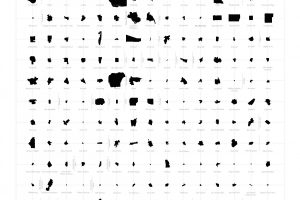
THESIS: The Atlas of Legal Fictions
Piper Bernbaum's thesis, The Atlas of Legal Fictions, reveals a little known reality, the Eruv, uncovering the nature of these religious boundaries and exposing the factual existence of what is considered fiction in the modern world. She will defend her thesis on Wednesday April 27th at 12.30pm in the BRIDGE Storefront.
THESIS: Energy and Matter
William Elsworthy will defend his thesis entitled Energy and Matter: The design of a nature centre, tunnel and neutrino observatory on Wednesday, January 7th at 2PM in the Architecture Loft.
Leave a Reply Cancel Reply
Save my name, email, and website in this browser for the next time I comment.
This site uses Akismet to reduce spam. Learn how your comment data is processed .
© 2024 — BRIDGE.
- Sustainable business
- Thesis Manual
- Submission specs
- Creating a PDF file
- Calculate spine width
- Sending files

Thesis Layout
Your thesis as creative design
Designing a Thesis?
Designing a thesis is an art in itself. After all, there has to be a good visual translation of the content.
Ridderprint has its own studio and an external network of professional designers. This way we make the right match with the professional that suits you.
We deliver a creative thesis design for the cover and layout. So that you can focus on the content.
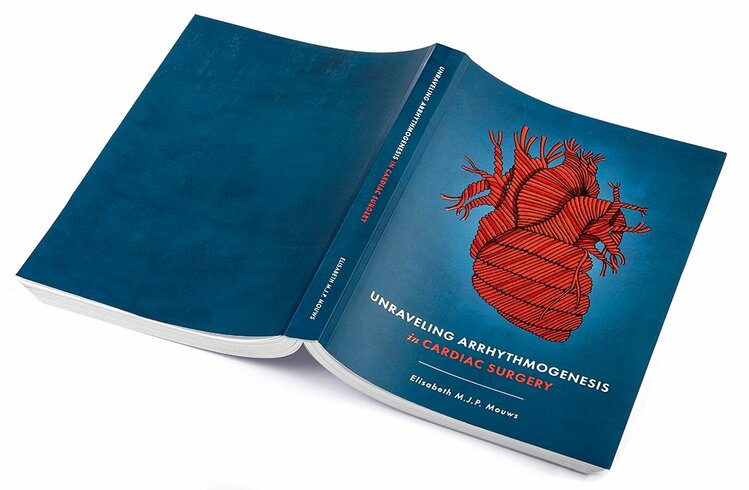
The packages
Inside pages, lay-out | inside pages: complete.
- A to Z layout of the inside pages
- Up to 30 tables
The complete layout from A to Z on the basis of your wishes. We have examples for you to choose from.
Choose the Complete Plus package if you have more than 30 tables.
The following layout elements can be determined for the layout:
– Font, size, and line spacing – Use of headlines – Headers and footers – Table of contents – References – Tables – Indexes – Title pages of chapters

LAY-OUT | Inside pages: Complete Plus
- More than 30 tables
Choose the Complete package if you have fewer than 30 tables.
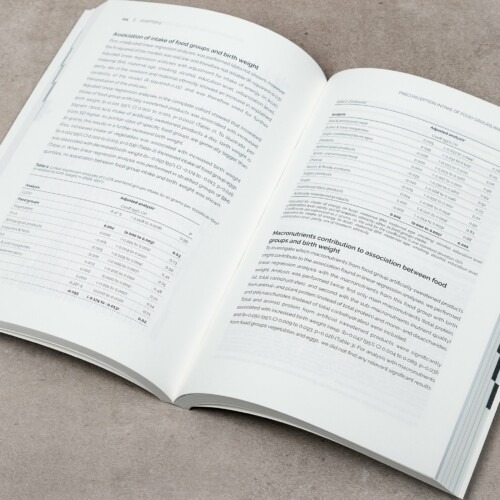
LAY-OUT | Inside pages: Standard PDF
- Adding layout elements to your PDF file
- Up to 3 layout elements possible
If you have created your own layout but still want to add something? You can do so with this package. You submit the complete PDF file. We can add a maximum of 3 layout elements to this PDF file.
You can choose styling for the following 3 layout elements:
- Indexes (chapter numbers on the side of your pages)
- Header and footer
- Title pages of chapters
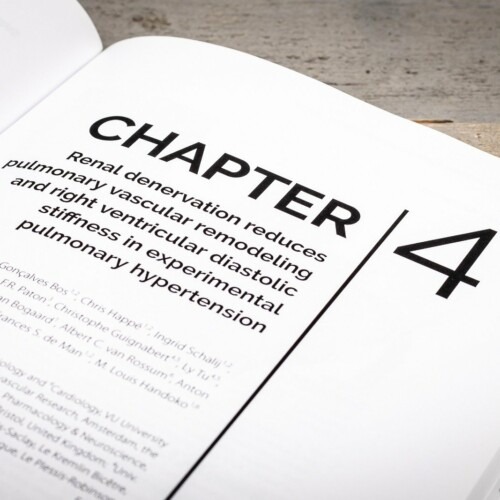
LAY-OUT | Cover: Standard
- The layout of the cover according to your wishes with the text and images submitted.
If you can provide the photos and text but you do not have the knowledge for creating a cover, this will be the package you need.
We combine your material into a technically correct cover. You can specify additional wishes such as use of color, type of font, etc.
If you are looking for a suitable image, this is possible on websites such as www.shutterstock.com . If you find something here, we can purchase the image(s) for you.
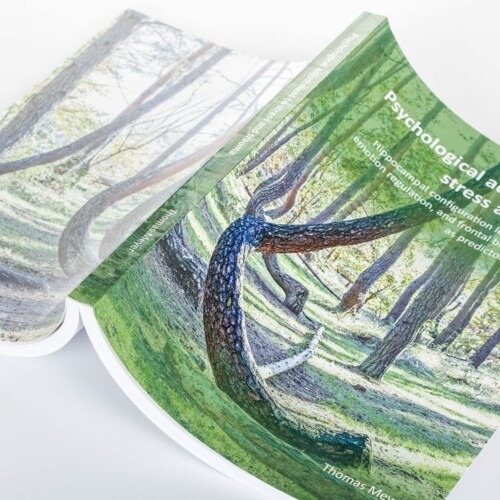
LAY-OUT | Cover: Design
- Complete design of the cover in collaboration with a graphic designer.
You want a unique cover? Then this is the package for you! In collaboration with a designer, you develop a concept into a custom cover.
In consultation we provide a suitable designer. In a conversation with the designer you discuss a concept to create something unique.
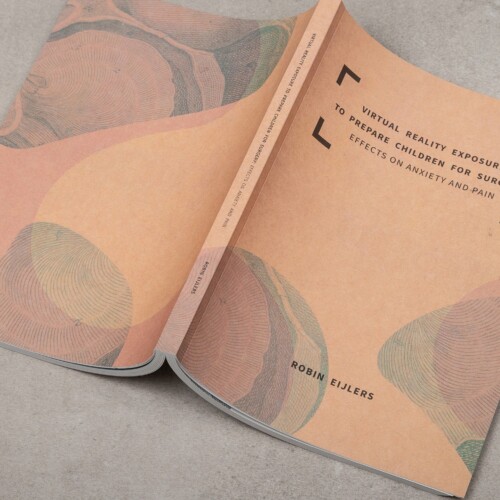
More than 25 years experience, and it shows in the quality of our service and work. Thesis design and high-quality printing. The newest techniques with sharp and vibrant prints. In our own design studio and great collaborations.
Personal attention
Ridderprint is the specialist in thesis layout and design! We aim for 100% customer satisfaction. To this end, we offer our customers flexibility and optimum personal guidance.
Do you want to get the best value for your budget? We provide comprehensive services and solutions for thesis layout and design, from standard to fully customized, with personal attention and excellent advice.
Thesis layout?
1. intake interview.
If you decide to have your thesis layout designed by Ridderprint, we will send you all additional information and we will plan your order. During an intake with a designer, your wishes and the files to be submitted are discussed.
2. Thesis design
Once the wishes for the thesis layout have been identified, a concept chapter is created. After you have approved the layout and styling, the rest of the thesis is processed. During this process, you will receive the layout for reviewing, in which you can make any corrections required.
3. Checking proof print
After the layout has been completed, you receive the proof, which you can check for content and quality. You will also receive an information card with some explanation about the proof. After you have checked the proof, you can inform the designer about any corrections that should be made on the thesis design. In this way, we work towards approval for production.
4. Production and delivery
You receive a production confirmation in which you can check the order details. After your approval, we start with the production. The delivery takes place with overnight shipment to the address agreed on, at normal business hours.
View a planning
This planning tool is based on the average process duration. This duration may take longer, depending on additional options.
For faster delivery, please contact us.
*A few copies of your thesis have to be submitted three to five weeks before your defense. Consult the promotion regulations on this point.
Frequently asked questions
How should i submit my thesis for layout.
We would like to receive the text in a Word document.
Which elements can be styled in the layout?
In our Complete (Plus) packages for the inside pages, you can have the entire thesis styled from A to Z, including:
- Font, size, and line spacing
- Use of headlines
- Headers and footers
- Table of contents
How should I submit my figures and images for the layout?
You can leave the figures as a reference in the Word document. We also want to receive these figures separately, as close to the source as possible so as to retain the best possible quality. The format of these separate files may vary (e.g. PDF or TIFF documents).
Which quality is required for the figures?
The optimum quality or resolution for images and figures is 300 DPI. Figures can also be submitted as vectors in their respective sources (e.g. EPS documents or EMF from PowerPoint).
How should I submit tables?
You can leave the tables in the Word document. These tables should consist of rows and cells. We can import these tables into our software and adjust the styling accordingly.
How long does the layout process take?
This depends on the package you choose and the creativity required. Our standard packages take several working days. Our Complete (Plus) and total packages may take two or three weeks. Check our planning tool to get some idea of how long the entire process takes.
How can I get my ideas across?
Depending on the package you choose, we have templates and examples for you. Together with the designer you can take stock of your wishes. These wishes will be made into a layout concept.
I have a specific idea. How should I go about it?
We work with in-house as well as external designers. We can decide which designers would be perfect for your wishes and ideas.
How many corrections can I indicate?
In our packages, 30 minutes are reserved for author corrections, for instance with respect to spelling errors or other inconsistencies. We recommend that you check the Word document carefully before sending it to us. This will lead to fewer corrections, and it will save you time while checking the concept and the entire layout.
What are the options for the look of my thesis?
We have various types of paper for the inside pages and cardboard for the cover. There are also various applications for embellishing the cover. Since the possibilities we offer are many, we have not shown all options in the offer request. If you want to be informed of all options, please contact us without obligations.
With the offer request you can also apply for our manual. Our standard paper types are included as examples. Some applications have been used on the cover of this manual.
Can I have my thesis designed?
You certainly can. On our layout page, you can view our packages.
Work we are proud of

DigitalCommons@RISD
Home > Center for Arts & Language > Thesis Writing > 2
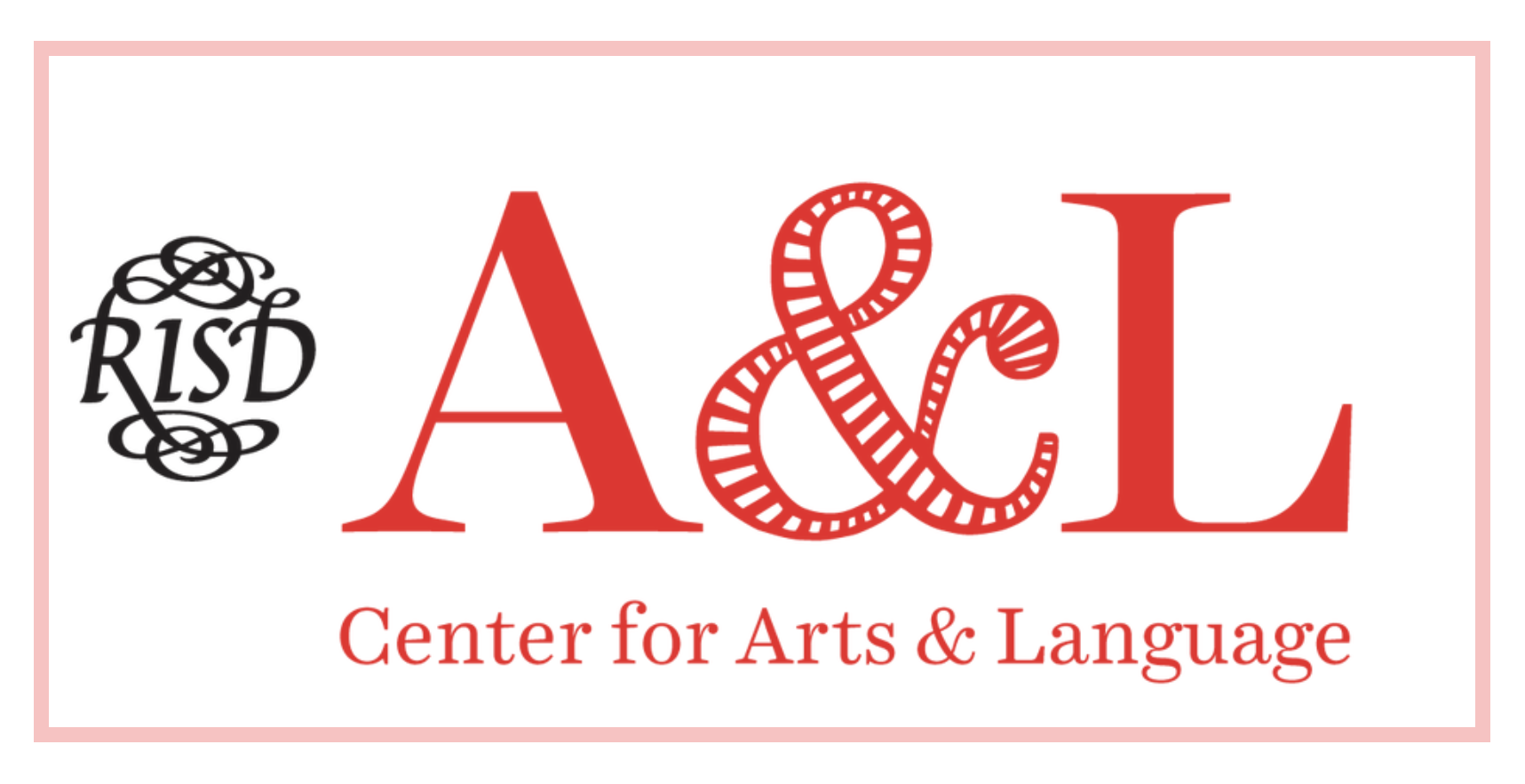
Thesis Writing

A Guide to Thesis Book Design
Marcus Peabody , Rhode Island School of Design Follow Center for Arts and Language , Rhode Island School of Design Follow
Download Full Text (436 KB)
Description
57 pages. "This guide is more basic and specific than other design manuals. Used in isolation it should tell you all you need to produce your book, even without prior graphic design knowledge. It could also be a starting point for a deeper dive into book design: other manuals that deal more thoroughly with elements such as book binding or typography are mentioned along the way for further reference." – from the introduction. "This book is set in Brandon Grotesque and Miller Text. Written and designed by Marcus Peabody (GD MFA 2019). Edited by Jen Liese and Meredith Barrett (A&L). Additional design and typesetting by Everett Epstein (GD MFA 2020)." – Colophon
Publication Date
© Rhode Island School of Design 2019
masters theses, thesis, dissertations, book design, case studies, electronic dissertations, graduate students, artists' books, book making, thesis book, academic writing, printing, guides
- Disciplines
Art and Design | Art Education | Book and Paper | Higher Education | Language and Literacy Education | Reading and Language | Technical and Professional Writing
Recommended Citation
Peabody, Marcus and Arts and Language, Center for, "A Guide to Thesis Book Design" (2019). Thesis Writing . 2. https://digitalcommons.risd.edu/centerforartsandlanguage_thesiswriting/2
Since April 01, 2021
Included in
Art Education Commons , Book and Paper Commons , Higher Education Commons , Language and Literacy Education Commons , Reading and Language Commons , Technical and Professional Writing Commons
To view the content in your browser, please download Adobe Reader or, alternately, you may Download the file to your hard drive.
NOTE: The latest versions of Adobe Reader do not support viewing PDF files within Firefox on Mac OS and if you are using a modern (Intel) Mac, there is no official plugin for viewing PDF files within the browser window.
- All Collections
- Departments
- Online Exhibitions
- Masters Theses
Advanced Search
- Notify me via email or RSS
Contributor Info
- Contributor FAQ
- RISD Center for Arts & Language
Permissions
- Terms of Use
Home | About | FAQ | My Account | Accessibility Statement
Privacy Copyright
2024 Graphic Design Thesis Exhibition
Share options.
- Share to Twitter/X
- Share to Facebook
- Share to LinkedIn
Event Actions
- Add to iCal
- Add to Google
This exhibition showcases the work of BFA, Graphic Design majors and represents the culmination of study in the Graphic Design Program.
The Graphic Design BFA Program focuses on design thinking, visual narrative, branding, motion graphics and UX/UI. There will be a public reception on May 14th, 5:00 p.m. – 6:30 p.m.
Exhibiting Students
- Mattingly Barkan – My Expression Progression: Educational App Design
- Melitta Deljanin – Pareidolia: Music Festival Branding
- Jeremy Fowler – Music Therapy
- Kevin Harinarine – Wave Links: Editorial Layout
- Nicole Hernandez – Amore: 360 Branding Campaign
- Justin Kresse – JK Serif: Typeface Design
- Dylan Mason – Astoria: 360 Branding Campaign
- Niyah Shaw – Trove: 360 Branding Campaign
- Michael Steinheimer – Petey & Friends: Children’s Show
If you have any questions, please contact assistant professor David Pierce at [email protected]
- Art and Art History ,
- Art Exhibit
- Current Students
- Parents & Families
- Alumni & Friends
- Local Community
- Student Profile
- Apply for Aid
- Billing
- Loans
- One-Stop Student Services
- Pay Your Bill
- Refunds
- Scholarships & Grants
- Tuition & Costs
- Tuition Insurance
- Add/Drop a Course
- Change Major/Minor
- Course Search
- Degree Audit
- Enrollment/Degree Verification
- Forms & Guidance
- Register for Classes
- University Bulletin (Course Catalog)
- Academic Calendar
- Academic Petitions
- Academic Resources
- Advisement
- Final Exams
- General Education
- Grading Policies
- International Services
- Learning & Writing Centers (Tutoring)
- Mentoring
- Study Abroad
- Assistive Technology
- Bridges to Adelphi (Neurodiversity)
- Housing Accommodations (Section 504)
- Learning Disability & ADHD Support
- Student Access Office
- Athletics (Adelphi Panthers)
- Bookstore
- Clubs & Activities (MyAULife)
- Commuter Student Services
- The Delphian (Student Newspaper)
- Diversity, Equity, Inclusion & Belonging
- Dining Services & Meal Plans
- Interfaith Worship
- Locker Rentals
- Lost & Found
- Multicultural Center
- Residential Life & Housing
- Student & Community Engagement
- Career & Professional Development
- Internships
- Job Search (Handshake)
- Leadership & Development
- On-Campus Jobs
- Prep for Success (Kaplan Career Core)
- Care Team
- Community Concerns & Resolution
- Conduct & Community Standards
- Report Harassment
- Title IX
- Apply to Graduate
- Commencement
- Health Insurance & Waiver
- Health Portal
- Health Services Center
- Immunization Requirements
- Infectious Disease Prevention (COVID-19)
- Mental Health Counseling & Support
- Mindfulness Center
- Nutritionist/Dietitian
- Panther Pantry & Food Insecurity
- Recreation & Fitness
- University Libraries
- My Library Account
- Library Services
- Clery Act
- Emergency Notifications (RAVE)
- Parking
- Report Suspicious Behavior (BIT Team)
- Shuttle Schedule
- Help Desk (Tech Support)
- Linkedin Learning
- Technology Services
- Disclosures & Info
- Student Consumer Info
- Student Disclosure
- Academic Catalog
- Financial Scholarly Support
- Curriculog
- Library
- Navigate
- OARAA
- Provost
- Research & Sponsored Programs
- Administrative Calendar
- Alice Brown Early Learning Center (Childcare)
- Brand & Style Guide
- Community Discounts
- Emergency Notification (RAVE)
- Faculty Payroll & Course Load
- Faculty Senate
- FCPE
- Human Resources
- LinkedIn Learning
- Paid Time-Off
- Public Safety & Transportation
- Technology
- Share Your News or Story
- University News
- University Events
- Administrative Calendar
- Accounts Payable
- Benefits
- Concerns and Resolutions
- Contracts
- Handshake / Post Jobs
- Staff Council
- Parents & Families Info
- Career Services
- High School Programs
- Tuition & Financial Aid
- FERPA
- General Education Requirements
- Registrar
- Paying a Bill
- Accessibility Office
- Availability of Employees
- Campus Map
- Handbooks & Brochures
- Health Services
- Parents & Families Association
- Athletics
- Performing Arts Center
- Adelphi Gold
- Discounts & Benefits
- Jobs at Adelphi
- Networking
- Order a Transcript
- Performing Arts Center
- Camps
- High School Programs
- Pre-College Programs
- Art Exhibitions
- Adult Fitness Program
- Gym Membership
- Continuing Education & Professional Development
- Community Auditing Program
- Credit for Prior Learning
- Breast Cancer Hotline & Support Program
- Hy Weinberg Center for Communication Disorders
- Institute for Parenting
- Literacy Center
- Mental Health Services
- Social Training Center
- Become a Mentor
- Center for Nonprofit Leadership
- Reserve Event Space
You are now leaving the Adelphi University website...
Adelphi is not responsible for the content of third-party sites. External sites may have different Privacy and Security policies than Adelphi University. You should review the policies of any third-party website before you provide personal or confidential information.
Go back Continue

ARCHITECTURAL THESIS

Creative Fields

Illustration

Architecture
- architecture
- ILLUSTRATION
No use is allowed without explicit permission from owner
More From Forbes
If tom doak is the neil young of golf course design, pinehurst no. 10 is his ‘cowgirl in the sand’.
- Share to Facebook
- Share to Twitter
- Share to Linkedin
An aerial view of the second hole at Pinehurst No. 10
It’s almost two years to the date that Pinehurst president Tom Pashley dialed up Tom Doak and asked him if he’d be down to design the resort’s tenth golf course. In the annals of golf course construction, to go from architect greenlight to completion in under 24 months is Usain Bolt fast.
“That is a year faster than anything I’ve done, except for one project I took over from another architect that was already permitted and ready to go,” Doak, who had prior commitments to projects set to start several months out, and needed to get going pronto so that he’d have his whole team on hand, said.
Doak, the Neil Young of course construction whose minimalist designs all possess their own unique character but are united in their ragged glory, is a fixture on all afficionados Mount Rushmore of living golf course architects. Pinehurst put the pedal to the metal, unleashing resources and cutting through the red tape to make No. 10 fit his schedule. Doak’s designs occupy 6% of Golf Magazine’s most recent Top 100 Courses in the World rankings with Ballyneal, Barnbougle, Cape Kidnappers and Pacific Dunes counting among the greatest tracks of the in-demand designer’s forty-something layouts sprawled around the world.
His brazen and beautiful newest creation, Pinehurst No. 10, the anchor of the North Carolina resort’s brand new Sandmines area , a 900 acre property situated five miles from the village (where No. 11 will go as well), is poised to join Doak’s hit parade.
“Hopefully the more you build, the better you get at the craft of building. The ideas and the concepts don’t change very much over time but you just get better at actually executing. When I built Pacific Dunes twenty-years-ago, I was like ‘there is no way I’m ever going to get another piece of land and client that good again to do a golf course and arguably I’ve had somewhere between five and ten that had that potential since, which does not cease to amaze me.”
Netflix: Marvel Dud Among Movies New On Streaming Service This Week
Houston rockets land third pack in upcoming nba draft, northern lights might be visible again tonight here s the updated aurora forecast.
Of course when you have as many courses that make the cut in the industry’s best in the world lists, the math of an individual architect, even a first page of the leaderboard one, adding another to the mix simply becomes that much harder—making addition by subtraction the likelier scenario.
“I’ve got a ridiculous number of golf courses in the top 100 golf courses in the world and you’re getting to that glass ceiling of ‘if this one gets voted in,’ one of those other ones is going to fall out because there still has got to be room for a bunch of Ross, Tillinghast and Macdonald courses and everybody else.”
Where No. 10 Fits In
No. 2, the wire-grass framed major championship mettle-tester set to stage the U.S. Open once again next month, is the resort’s undisputed crown jewel. But No. 10, the newbie where golfers traverse epically sprawling terrain—with the number of visually intimidating vistas and ascents and descents through a former quarry works on par with the prettier stretches of the Hobbits’ trek from the Shire to Mordor in Lord Of The Rings— should have it jockeying with visitor favorites No. 4 and No. 8 for the runner-up spot on resort guests’ must-play lists.
Tom Doak hits out of the sand
“Pinehurst No. 2 has always been one of my favorite courses in the world. You are not trying to imitate that but you are trying to build something that feels like it is a cousin or a sister. The interesting part is I know this golf course is more difficult than Tom Pashley or Bob Dedman Jr. [Pinehurst’s CEO] expected. We didn’t really set out to do that, that’s just the way the routing worked out,” Doak explained.
Doak is known to build golf courses not for tour pros but for recreational players trying to break 90 and while a grueling gauntlet of tough holes on this one from the 9 th -14 th may make some players question that thesis, a much breezier closing stretch balances the scales.
“You struggle to make pars through that stretch of the golf course but that’s not going to prevent you from breaking 90,” Doak commented.
While earmarking a signature on a course of this caliber is a fool’s errand, the par 4 eighth, a hackle-raiser featuring a nearly blind shot toward an imposing T-Rex tall mound has garnered the most press attention. The dino-sized Matterhorn that stares the tee box down is also flanked by a handful of black diamond skill hill moguls. Lead associate Angela Moser noted that once the trees were cleared in the vicinity, the idea to prominently incorporate the 25-foot protrusion, a vestige of the sand mining operation, entered her mind.
She noted some of the handiwork of Harry Colt’s pine forest set De Pan in the Netherlands as an inspiration for the resulting humdinger of a hole.
“It’s really beautiful rolling terrain with humps, bumps and lots of heather. There are a couple holes that have nearly blind or completely blind shots and from the very start of my golf career, I always thought that was very cool. You don’t see where you have to go, so you just have to trust it,” she said of the vaunted layout south of Amsterdam.
Just as running from your fear is often bad advice, Moser suggests that confronting the challenge head-on is the key to conquering the wild-looking eighth hole. By taking dead aim at the hefty heap, players gain a strategic advantage.
“If you hit it further to the right and take on the big mound, then you have a good angle into the green,” she said.
The saving grace for Doak of the hole is that since it’s a short par 4, it may look imposing but you’re still probably hitting a nine iron into the green and he’s much more likely to hear bellyaching from golfers on the par 4’s that may seem overlong like the 508-yard 13 th .
Golf courses are living breathing landscapes and often don’t reach full bloom once a ribbon is cut. Over time as the native areas fill in with vegetation, No. 10 will reach its full potential.
“It’s almost like gambling, you throw a lot of seed in the dark soil but you have no idea what will pop up. We’ll see how this place looks in two to three years,” Moser explained, adding that she hopes to see lots of blueberry bushes bloom.
Standing the test of time is the ultimate test for golf courses, and even an architect of Doak’s acclaim has seen a handful of his works disappear years later, which is what made a golf mecca like Pinehurst that has been maintaining courses since 1895 especially attractive.
The eleventh hole at Pinehurst No. 10
“I’ve built somewhere between 45-47 golf courses and that counts five that are no longer in existence which sucks—most of those were a year of my life to build them and when they’re gone it’s like ‘well that was a lot of time and effort for nothing’. We know that’s not happening here and that they’ll take care of it really well,” he said.
In the 1990s, long before Tom Doak’s reputation as a rock star golf course designer was ingrained, he and then intern Gil Hanse, who went on to redesign Pinehurst No. 4, visited the resort.
The duo was told by management that Pinehurst was planning to build two more golf courses and that Robert Trent Jones, Rees Jones or Jack Nicklaus were who they were considering to design them.
When they were heading out, Gil turned to his mentor and said ‘doesn’t it bother you that they’d never consider us?’ but Doak shrugged it off telling him that they’ve got to choose the best people of the time.
“Gil Hanse and I are just lucky that they didn’t do those courses then and when they finally did, in the game of musical chairs we were next to the chairs.”
- Editorial Standards
- Reprints & Permissions
Join The Conversation
One Community. Many Voices. Create a free account to share your thoughts.
Forbes Community Guidelines
Our community is about connecting people through open and thoughtful conversations. We want our readers to share their views and exchange ideas and facts in a safe space.
In order to do so, please follow the posting rules in our site's Terms of Service. We've summarized some of those key rules below. Simply put, keep it civil.
Your post will be rejected if we notice that it seems to contain:
- False or intentionally out-of-context or misleading information
- Insults, profanity, incoherent, obscene or inflammatory language or threats of any kind
- Attacks on the identity of other commenters or the article's author
- Content that otherwise violates our site's terms.
User accounts will be blocked if we notice or believe that users are engaged in:
- Continuous attempts to re-post comments that have been previously moderated/rejected
- Racist, sexist, homophobic or other discriminatory comments
- Attempts or tactics that put the site security at risk
- Actions that otherwise violate our site's terms.
So, how can you be a power user?
- Stay on topic and share your insights
- Feel free to be clear and thoughtful to get your point across
- ‘Like’ or ‘Dislike’ to show your point of view.
- Protect your community.
- Use the report tool to alert us when someone breaks the rules.
Thanks for reading our community guidelines. Please read the full list of posting rules found in our site's Terms of Service.

IMAGES
VIDEO
COMMENTS
Time to recap…. And there you have it - the traditional dissertation structure and layout, from A-Z. To recap, the core structure for a dissertation or thesis is (typically) as follows: Title page. Acknowledgments page. Abstract (or executive summary) Table of contents, list of figures and tables.
"Frames and Borders" thesis layout. Arina Pozdnyak. 69 1.5k. Save — — Ci sarà una volta | Editorial. Multiple Owners. 583 5.1k. Save — — Master Thesis Documentation : Zufall & Design ... FASHION DESIGN THESIS. Anna Giuliani. 1 43. Save. Museum Nasional #Thesis. Ama Dewi. 392 4.7k. Save. Infographics - Undergraduate Thesis Precedent ...
Dissertation & Thesis Outline | Example & Free Templates. Published on June 7, 2022 by Tegan George.Revised on November 21, 2023. A thesis or dissertation outline is one of the most critical early steps in your writing process.It helps you to lay out and organize your ideas and can provide you with a roadmap for deciding the specifics of your dissertation topic and showcasing its relevance to ...
Thesis Format. Thesis format refers to the structure and layout of a research thesis or dissertation. It typically includes several chapters, each of which focuses on a particular aspect of the research topic. The exact format of a thesis can vary depending on the academic discipline and the institution, but some common elements include:
Next go to "Page layout" and then "Breaks". Next, choose the submenu "Next page". Switch to the side, where the numbering should begin (in this case, page 2). In the edit mode of the header or footer, choose "link to previous", after that click on "Move to footer" and click on the "Link to previous" again.
The final copy of the thesis must be converted to .pdf (PDF/A format) for submission to the Library (maximum 600 mb). See the guide Saving your thesis in PDF/A format for instructions. Theses must be formatted for US Letter (8.5X11) pages. Landscape 8.5X11 and 11X17 pages are permitted. Legal, A4, or other paper sizes are not permitted.
The Grid. The grid is your underlying structure which helps create visual hierarchy by sizing and positioning images and text to create a coherent design. The grid is the graphic expression of a set of assumptions about the permissible sizes and shapes of images and blocks of text. It enables you to achieve and sustain design consistency.
The title page (or cover page) of your thesis, dissertation, or research paper should contain all the key information about your document. It usually includes: Dissertation or thesis title. Your name. The type of document (e.g., dissertation, research paper) The department and institution. The degree program (e.g., Master of Arts)
Layout Design of my recently finished Master Thesis Book
Writing your thesis is already difficult enough. That is why you can read below how to design a perfect thesis layout with 5 easy tips. This way you will without a doubt impress with your thesis layout! Whether you write your thesis in Microsoft Word, Pages (Mac) or Google Docs, you can use these tips in all these programs.
That is why we do everything in our power to make this possible. GreenThesis offers you a free Word template for your thesis layout, when you let us design your cover. With this template, you can easily create a sleek and minimalist layout yourself without spending capital. If you still need help, we can provide it at a reasonable rate.
UCI Libraries maintains the following templates to assist in formatting your graduate manuscript. If you are formatting your manuscript in Microsoft Word, feel free to download and use the template. If you would like to see what your manuscript should look like, PDFs have been provided.
A layout design for a friend's graduate thesis in 2009. He wanted it clean and easy to read and produced on a student's budget.The thesis was written during an internship with a research company and had to document his findings and conclusions.
Some grads trade studio work for thesis book design with current Graphic Design students. You could even not design your book at all. You could print it 12pt double-spaced Times New Roman and ... of distinct options for say typefaces or image layout. Go broad with them and make a range of options—perhaps don't even think about your thesis ...
This is a non-official MS Thesis Template for NYU Tandon. Following the most recent guidelines of 2023, I updated the NYU PhD Dissertation template to match the MS Thesis Guidelines. Produce beautiful documents starting from our gallery of LaTeX templates for journals, conferences, theses, reports, CVs and much more.
Insert page breaks for all other 'heading 1' headings (Layout -> Breaks -> Page) Adding Page Numbers. Insert -> Page Number and choose a position on the page; Double click on title page header or footer (top or bottom of the page) and tick 'Different First Page' in the Design ribbon that appears
Create a paragraph style called "endnotes". In "Paragraph Style Options" under "Bullets and Numbering" choose "Numbers" for list type - you can change the look of the number under Character style. Insert/type your endnotes into a text box and apply the "endnotes" style - each note will now have an assigned number.
2. Thesis design. Once the wishes for the thesis layout have been identified, a concept chapter is created. After you have approved the layout and styling, the rest of the thesis is processed. During this process, you will receive the layout for reviewing, in which you can make any corrections required.
Description. 57 pages. "This guide is more basic and specific than other design manuals. Used in isolation it should tell you all you need to produce your book, even without prior graphic design knowledge. It could also be a starting point for a deeper dive into book design: other manuals that deal more thoroughly with elements such as book ...
A research design is a strategy for answering your research question using empirical data. Creating a research design means making decisions about: Your overall research objectives and approach. Whether you'll rely on primary research or secondary research. Your sampling methods or criteria for selecting subjects. Your data collection methods.
Typography. Product Design. Print. Illustration. Branding. Web Design. Mobile. Discover 2 Thesis Layout designs on Dribbble. Your resource to discover and connect with designers worldwide.
Mastering CSS for design and layout involves understanding how different CSS properties interact with HTML elements. This includes knowledge of how to manipulate the box model, positioning, typography, colors, backgrounds, and transitions, among other things. The more proficient you become in CSS, the more control you have over the visual ...
This exhibition showcases the work of BFA, Graphic Design majors and represents the culmination of study in the Graphic Design Program. The Graphic Design Program focuses on design thinking, visual narrative, branding, motion graphics and UX/UI. There will be a public reception on May 14th, 5:00 p.m. - 6:30 p.m.
Illustration,Architecture,SketchUp,Lumion,Adobe Photoshop,AutoCAD. An Undergraduate Thesis │ National University, Manila │ Tanauan City, Batangas
Online Resume: Develop an online resume template where users can input their information, skills, and experiences, and customize the layout and design. Product Landing Page: Design a landing page for a product or service, including features like product descriptions, pricing, testimonials, and a call-to-action button. Intermediate Projects
An aerial view of the second hole at Pinehurst No. 10. It's almost two years to the date that Pinehurst president Tom Pashley dialed up Tom Doak and asked him if he'd be down to design the ...
Step 2: Write your initial answer. After some initial research, you can formulate a tentative answer to this question. At this stage it can be simple, and it should guide the research process and writing process. The internet has had more of a positive than a negative effect on education.
In this paper, a new type of assembling rivet-fastened rectangular hollow flange beams (ARHFBs) is proposed. The cross-section of the ARHFB consists of two U-shaped and C-shaped components connected by self-locking rivets to form two rectangular hollow flanges. To study the performance and strength of the ARHFB as a flexural member, eight four-point bending tests and more than 40 simulation ...